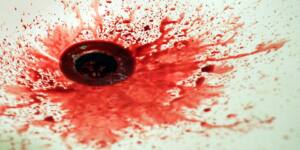Blood Evidence: Basics and Patterns
 The discovery of blood in a case opens up a mini investigation within the investigation. This is because an investigator must initially determine if a crime has been committed. It’s important to determine if a crime has been committed because the presence of blood does not necessarily mean that there ever was a crime. This determination has to be made in a case where a person is reported missing since it will help investigators. The blood found can then be tested and see if it belongs to the victim; if the blood does belong to the victim there is a possibility that a crime has been committed and that the case could change. Blood evidence also comes in to play in criminal cases. Blood found on the blade of a knife could mean that a crime was committed and someone was stabbed- but it could also mean that the victim sliced their own finger. Even though there may be a crime where someone has been stabbed, it has to be determined that a crime was committed with that particular knife. The red substance that has been found is tested. Initially the blood is tested to determine if it is blood, and then if it is human blood. Once the substance has been tested and it’s been determined that it is blood and it is human blood, it can be determined if the blood came from the victim or the suspect. Blood evidence isn’t just collected off of weapons, but can also be collected off of the floor or other surfaces in a crime scene. This blood is also tested to determine if the blood came from the victim or the suspect.
The discovery of blood in a case opens up a mini investigation within the investigation. This is because an investigator must initially determine if a crime has been committed. It’s important to determine if a crime has been committed because the presence of blood does not necessarily mean that there ever was a crime. This determination has to be made in a case where a person is reported missing since it will help investigators. The blood found can then be tested and see if it belongs to the victim; if the blood does belong to the victim there is a possibility that a crime has been committed and that the case could change. Blood evidence also comes in to play in criminal cases. Blood found on the blade of a knife could mean that a crime was committed and someone was stabbed- but it could also mean that the victim sliced their own finger. Even though there may be a crime where someone has been stabbed, it has to be determined that a crime was committed with that particular knife. The red substance that has been found is tested. Initially the blood is tested to determine if it is blood, and then if it is human blood. Once the substance has been tested and it’s been determined that it is blood and it is human blood, it can be determined if the blood came from the victim or the suspect. Blood evidence isn’t just collected off of weapons, but can also be collected off of the floor or other surfaces in a crime scene. This blood is also tested to determine if the blood came from the victim or the suspect.
Besides testing, investigators use blood stain patterns to help determine if a crime was committed. There are different types of blood stain patterns that an investigator looks for, these patterns are as follows:
•Drip Stains/Patterns – blood stain patterns that are created due to the force of gravity acting on liquid blood.
•Blood Dripping into Blood
•Splashed (Spilled) Blood
•Projected Blood (with a syringe)
•Transfer Stains/Patterns -A transfer bloodstain pattern is created when a wet, bloody surface contacts a surface that is not bloody. With this type of pattern, part or the entire original surface may be recognizable, a full or a partial shoe print, for example.
•Spatter Patterns- Blood spatter patterns are created when an exposed blood source is subjected to an action or force greater than gravity (internally or externally)
•Castoff- A blood stain pattern that is created when blood is released or thrown from a bloody object in motion.
•Impact –A blood stain pattern resulting from an object striking liquid blood
•Projected-A blood stain pattern that is produced by blood being released under pressure–for example, arterial spurting.
•Shadowing/ Ghosting- When there is an empty space or “void” in the spatter. This indicates that there was an object in the way.
•Swipes and Wipes- Swipes occur when blood on a surface is smeared. Wipes occur when a bloody object brushes against a surface.
•Expiratory Blood – Blood that is coughed or breathed out. This is indicated by a misty pattern that resembles high velocity spatter results.
Back to Forensic Investigation
Back to Crime Library
|
|
|

